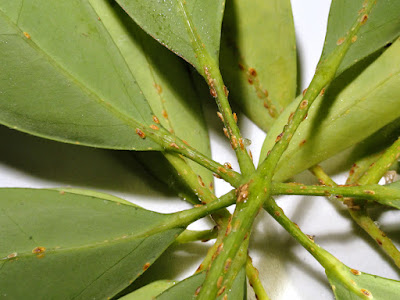 |
| A plague on all their houses! |
 |
| A closer view. Scales, sticky sap, bubbles of honeydew. |
These are soft scale insects, Coccidae, feeding on the plant juices, gradually killing their host. They don't look like insects; all that's visible is a shell glued to the stem or veins of the plant, like a limpet to a rock. But the limpet wanders about; these do not.
They are probably all females; some species reproduce by parthenogenesis, without the need for a male. In other species, the males live for only a short time; they do not feed.
Female scale insects attach themselves to a handy location, and settle down to eat and lay eggs, 1000 or more in a season. They cover themselves and their eggs with a thin coat of wax and feces. As they feed, they excrete excess liquid through pores in various places; this is a sweet, sticky substance, called "honeydew". It covers the leaves and stems, attracting fungus spores and, on houseplants, dust.
 |
| Little bird from Chinatown apologizes for not eating the bugs. |
I broke off the stems and leaves where the scale insects were thickest. Some of the scales fell off, so I collected them to get a better look at them.
 |
| Side view, showing the waxy cap, and the mass of eggs or young underneath. |
When the female dies, her eggs remain protected underneath her dead body until they are ready to hatch.
 |
| The largest scale I found, just over 3 mm. (1/8 inch) long. She was dead, her babies long gone. |
 |
| Several sizes and conditions. Upper left, on top of the pile, what looks like white wax emerges from a central rear pore. Extreme right, center, a dead, empty shell, upside-down. |
Most of the scales that had fallen off seemed to be dead and empty, but as I examined them, one started to rock. Then a very tiny, almost transparent baby crawled out from underneath. As I watched, others joined her.
 |
| Medium -sized nymph, about 1.5 mm. long. |
 |
| The tiniest crawler, half a millimeter long. If you look very closely you can see a hint of legs. She could move at a pretty good pace for her size. |
I don't know if those two black spots in front are eyes. Someone asked about that on BugGuide, but got no answer.
Only the newly-hatched insects crawl about; once they've found a good feeding spot, they settle down. In some species, they lose their legs entirely.
And now it was time to rescue my poor plant. The leaves I had removed went into the garbage, sealed in a plastic bag. I put the Schefflera in the shower and hosed it down thoroughly with lukewarm water and lots of soap. I took off the top layer of soil and scrubbed the pot, too. When it dried, I checked it over and discovered a couple dozen more scales; these I squashed.
Tonight, the plant looked healthy, but I found another few small scales along the veins of leaves, and removed them. I will have to continue monitoring until I know all the nymphs are gone.
There's an excellent photo of one of these, by Scott Justis, on Flickr, here's Wikipedia on the scale insects, and the USDA Systematic Entomology Laboratory, has a good discussion of the Coccid family.

Fascinating. I dislike scale insects. An odd one, here or there, is interesting. When they infest a plant, they can be quite disgusting. Have only come across hard ones. I imagine soft ones are even more unpleasant. None the less - your photos are fantastic - and fantastically interesting.
ReplyDeleteIn the summer, these guys seem to dry up in direct sunlight. However, in the winter, it's a full blown infestation with leaves dropping off the indoor plants as if it were autumn. You remind me that I need to clean up my plants if they are to have a chance of surviving till spring.
ReplyDeleteThey're persistent little bugs. I had problems with them on the tropical figs that I had as potted plants when I lived down south. Despite liberal application of white oil, they survived. Like you, I had to resort to scraping and squashing. Didn't eradicate them, but did keep them under control. Good luck!
ReplyDelete(The Schefflera are fruiting in the forest now. The birds think it's wonderful.)
Scraping and squashing; I cleaned off another dozen tonight.
ReplyDeleteI have a good-sized avocado tree just below the Schefflera, and I started to worry about it. I just checked; not a bug on it. Maybe avocados are resistant. I hope.